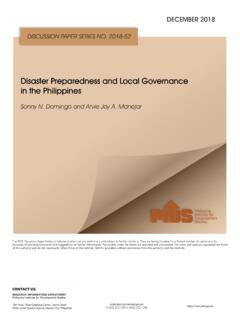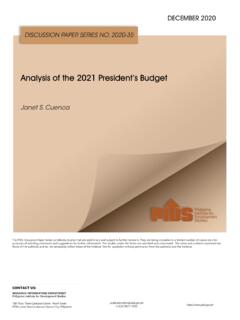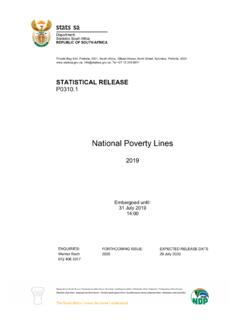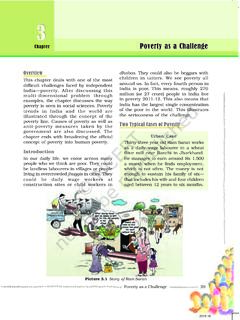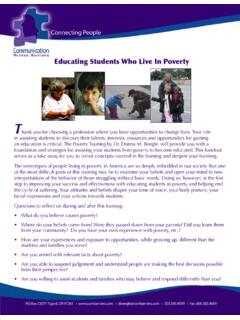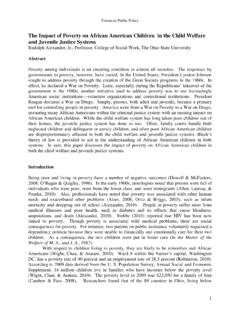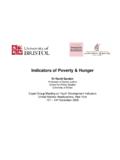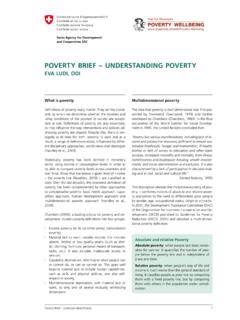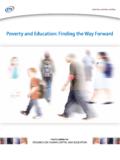Transcription of Vulnerability to Poverty in the Philippines: An ...
1 DISCUSSION PAPER SERIES NO. 2018-10 AUGUST 2018 Vulnerability to Poverty in the Philippines: An Examination of Trends from 2003 to 2015 The PIDS Discussion Paper Series constitutes studies that are preliminary and subject to further revisions. They are being circulated in a limited number of copies only for purposes of soliciting comments and suggestions for further refinements. The studies under the Series are unedited and unreviewed. The views and opinions expressed are those of the author(s) and do not necessarily reflect those of the Institute. Not for quotation without permission from the author(s) and the US:ReseaRch InfoRmatIon DepaRtmentPhilippine Institute for Development Studies18th Floor, Three Cyberpod Centris - North Tower EDSA corner Quezon Avenue, Quezon City, 372-1291/(+632) 372-1292 Ramon G.
2 Albert and Jana Flor V. Vizmanos Vulnerability to Poverty in the Philippines: An Examination of Trends from 2003 to 2015 Jose Ramon G. Albert and Jana Flor V. Vizmanos PHILIPPINE INSTITUTE FOR DEVELOPMENT STUDIES August 2018 1 Abstract The reduction of Poverty is at the heart of the development agenda both nationally and globally. This is reflected in the Philippine Development Plan, and the worldwide commitment toward the Sustainable Development Goals. While the measurement of Poverty is ex post and thus public interventions are directed at helping those who have been identified as poor, the government must broaden the scope of assessments and take account of the dynamics in Poverty in public policy.
3 A critical dimension to Poverty dynamics is Vulnerability which conceptually pertains to the risk to future Poverty . Some of the poor are likely to be poor in the future; some non-poor may also become poor if idiosyncratic and covariate risks to future Poverty are not addressed. Thus, risk resilience management strategies are critical. This study continued previous work that involves estimating the Vulnerability level of households to income Poverty using a modified probit model based on income and other Poverty correlates data sourced from the Family Income and Expenditure Survey, as well as the country s official Poverty lines.
4 Past model specifications are improved on by including data on price and climate shocks to welfare, as well as generating the assessment for urban areas alone and for rural areas alone before combining the cross-section results, rather than using a common specification nationally as was done previously. The Vulnerability assessment in this study provide inputs to forward-looking interventions that build the resilience of households for preventing or reducing the likelihood of future Poverty . The study makes a case for the need to make use of both Poverty and Vulnerability estimates in programs, and come up with differentiated actions for those highly vulnerable and relatively vulnerable.
5 Keywords: Vulnerability , Poverty , highly vulnerable, relatively vulnerable, risk, resilience. 2 Table of Contents 1. Introduction .. 4 2. The macroeconomy, Poverty and Vulnerability .. 6 3. Methodology .. 13 Vulnerability Estimation under Expected Poverty .. 13 Estimation 17 4. Empirical Findings .. 17 Findings from Panel Data .. 19 Overall Trends in Vulnerability .. 20 Vulnerability of Basic Sectors .. 23 Sources of Risks of Income Variability .. 24 5. Policy Issues and Ways Forward .. 27 Poverty Focus of SocPen .. 29 Integrating Data on Poverty and Vulnerability for Social Protection.
6 33 6. References .. 35 List of Boxes Box 1. A Framework for Analyzing Vulnerability to Poverty .. 12 Box 2. Variables Used for Estimating Vulnerability .. 15 List of Tables Table 1. Growth Elasticity of Poverty : 2003-2006, 2006-2009, 2009-2012 and 2012-2015 .. 8 Table 2. Distribution of the Poor and Low-income Non-poor Filipinos (in 000s) across Urban and Rural Areas: 2003 and 2009 .. 8 Table 3. Poverty Transition Matrix (in Percent of Households in 2003): 2003 - 2009 .. 9 Table 4. 2003 Household Poverty and Vulnerability .. 18 Table 5. 2003 Household Vulnerability and Household Income Group Status.
7 18 Table 6. Vulnerability Status of Households in 2003 by Income Groups in 2006 and 2009.. 19 Table 7. Household Income Groups in 2006 and 2009, by Vulnerability Status in 2003 .. 19 3 Table 8. Vulnerability Status of Households in 2003 in Urban and Rural Areas : 2003, 2006 and 2009 .. 22 Table 9. Poverty and Vulnerability Rates for Basic Sectors .. 23 Table 10. Incidence of Vulnerability Among Households, by Highest Educational Attainment of the Head : 2015 .. 25 Table 11. Vulnerability Status of Households in 2015 by Major Income Source of Household Heads in 2016.
8 25 Table 12. SocPen Targets and Accomplishments: 2011-2018 .. 30 List of Figures Figure 1. Growth in Gross Domestic Product by Major Sector: Philippines, 2003-2015 .. 6 Figure 2. Gross Regional Domestic Product Growth (in %) by Region : 2003-2015 .. 7 Figure 3. Number of Natural Disaster Events, by Type of Disaster: 2003-2015 .. 11 Figure 4. Incidence of Household Vulnerability by Poverty Status: 2003, 2009, 20 Figure 5. Proportion of Households that are Highly Vulnerable and Relatively Vulnerable, by Income Groups: 2015 .. 21 Figure 6.
9 Incidence of Household Vulnerability By Region: 2015 .. 22 Figure 7. Average Number of Young and Adult Members in Urban and Rural Areas by Household Vulnerability Level: 24 Figure 8. Household Vulnerability Rates by Major Sector of Employment of the Household Head: 2003, 2006, 2009, 2012, 2015 .. 27 Figure 9. Social Protection Operational Framework and Implementation Strategy.. 29 Figure 10. SocPen Payouts in Taguig City .. 30 Figure 11. Share (%) of Senior Citizens with Pension .. 31 4 Vulnerability to Poverty in the Philippines: An Examination of Trends from 2003 to 2015 Jose Ramon G.
10 Albert and Jana Flor V. Vizmanos* 1. Introduction The Sustainable Development Goals (SDGs), a set of 17 goals that the Philippines and 192 other UN member states have committed to attaining by 2030, identifies a shared vision of, by and for all nations of the world: a better future for the people and its planet by promoting, prosperity, peace, and partnership (UN 2015). SDG1, the first of the 17 Global Goals (as the SDGs are also referred to) is to End Poverty in all its forms everywhere. Poverty reduction is thus critical to the sustainable development agenda.







